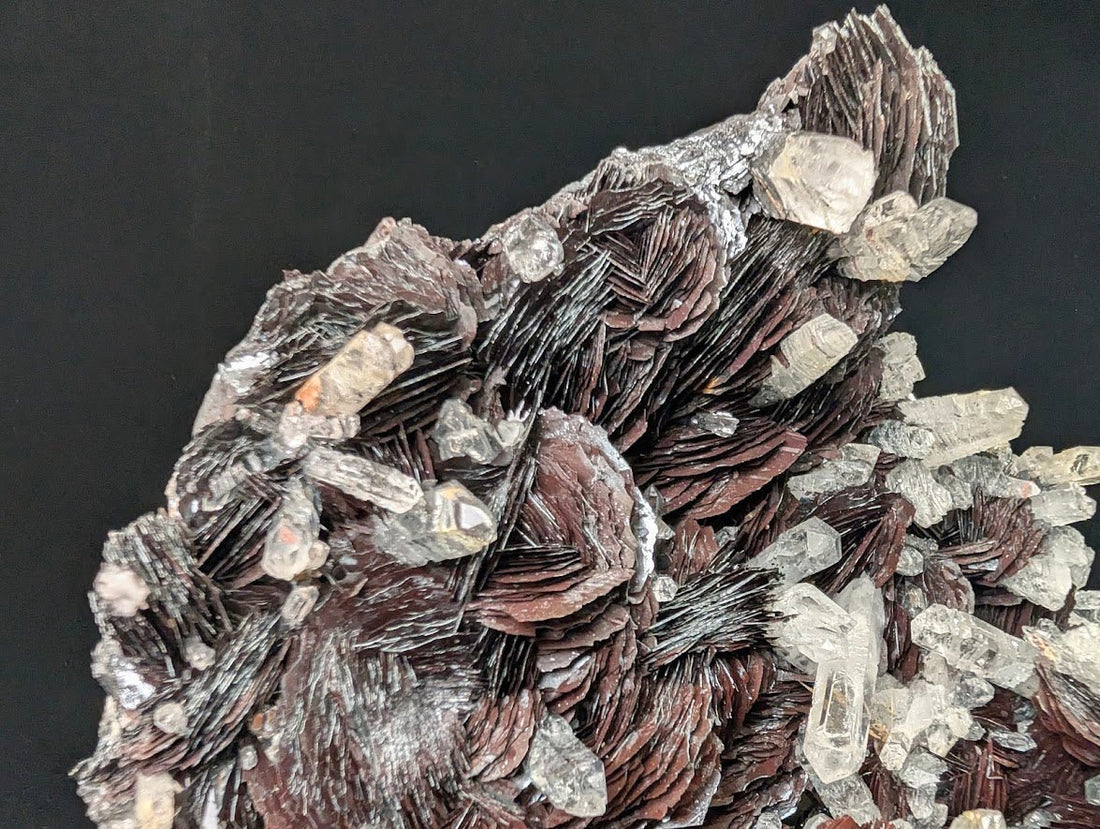
Hematite — The Collector’s Stone with Grounding Energy
Share
With its rich metallic sheen and deep energetic presence, hematite is more than just beautiful — it’s foundational. Here's why collectors and energy workers alike value this iconic mineral.
What Is Hematite?
Hematite is an iron oxide mineral (Fe₂O₃) formed through both igneous and sedimentary processes. Its name comes from the Greek word haima, meaning “blood,” referencing the red streak it leaves behind — despite often appearing silver-black in its polished form.
It crystallizes in the trigonal crystal system and occurs in several forms: botryoidal (rounded masses), tabular crystals, and micaceous (flake-like) structures. Natural hematite is often magnetic, dense, and strongly grounding — both energetically and physically.
Visual Appeal and Forms
Hematite can take on several collectible forms depending on its environment of formation:
- Specular Hematite – Also called “micaceous hematite,” it features silvery flakes that shimmer under light.
- Botryoidal Hematite – Smooth, bubble-like forms with a soft luster, often found in older European and Chinese deposits.
- Red Hematite over Quartz – A favorite among collectors, where hematite coats or inclusively stains quartz crystals with dramatic red hues.
- Iron Roses – Delicate, rose-shaped hematite crystal formations — particularly rare and admired in alpine finds.
Some of the finest specimens come from China (notably from Longyan, Fujian and Tongshan, Anhui), Brazil, and Switzerland, as well as classic pieces from England and Morocco.
Specialty Habits and Rare Collector Types
Iron Rose Hematite
One of the most celebrated forms, the Iron Rose, is a radial growth habit where tabular crystals form layered rosette-like shapes. These specimens are especially associated with Alpine clefts in Switzerland and are prized for their sculptural elegance.
Specular Hematite
Often from the USA (notably Michigan), specular hematite appears as silvery sheets or platelets with intense sparkle. These are popular with both metaphysical users and collectors due to their texture and shimmer.
Hematite Inclusions
Hematite frequently appears as a red or rust-colored inclusion inside other minerals like quartz or calcite. Included quartz with hematite “phantoms” from Tongshan and Longyan in China are especially desirable, blending the clarity of quartz with the deep energy of hematite.
Metaphysical Properties: Grounding and Protection
Hematite is widely known as a grounding stone — said to connect the wearer to Earth energy and promote stability, protection, and confidence. Its dense, iron-rich structure makes it a favorite for those seeking to feel balanced, focused, and safe in chaotic environments.
In energy work, hematite is associated with the root chakra:
- ⚫ Black/Silver Hematite – Root chakra (stability, grounding, energetic protection)
It’s often used to:
- Balance scattered energy and bring attention back to the body
- Support spiritual boundaries and reduce energetic fatigue
- Enhance discipline, focus, and logical decision-making
- Create protective fields during meditation or public interaction
How to Use Hematite
Hematite can be worn, carried, or placed in the environment to influence energy. Common practices include:
- Placing hematite near entryways to stabilize the home’s energy
- Wearing hematite bracelets for grounding during high-stress days
- Keeping a palm stone nearby during meditation for presence and stillness
- Working with included quartz + hematite combinations to connect clarity and root support
Global Hematite Localities
Hematite occurs around the world, but some localities are especially important for collectors:
- Longyan, Fujian (China) – Red hematite over quartz clusters with intense color saturation
- Tongshan, Anhui (China) – Phantom quartz with hematite inclusions; tabular growth
- Itabira District, Brazil – Massive and layered hematite, often in industrial + gem-quality form
- Elba Island, Italy – Historic red and metallic hematite nodules used since Roman times
- Swiss Alps – Iron rose habit hematite in quartz-filled alpine clefts
- Lake Superior Region, USA – Specular hematite and historic iron deposits
- Midlothian, Scotland / Cumbria, England – Classic red botryoidal hematite from 1800s lapidary sources
Collector’s Buying Checklist
- Luster: High-quality hematite should have a metallic or sub-metallic shine, depending on form.
- Color Contrast: Red hematite over quartz or calcite adds strong aesthetic value.
- Shape: Look for iron roses, tabular crystals, or shimmering micaceous flakes.
- Condition: Check for sharp edges, undamaged surfaces, and signs of repair or polishing.
- Origin: Top localities include Longyan, Tongshan, Brazil, Switzerland, and Italy.
- Energy Use: Choose denser pieces for grounding work, lighter ones for pocket stones or grid building.
Final Thoughts: Substance and Strength
Hematite is one of the few minerals that bridges the gap between intense, protective energy and sleek, visual beauty. Whether in raw, polished, or included form, it remains one of the most versatile pieces you can add to a collection.
At Legacy Crystals and Minerals, we seek out hematite specimens that speak to both the science and the spirit — from dramatic red inclusions to high-luster metallic plates that command attention.



